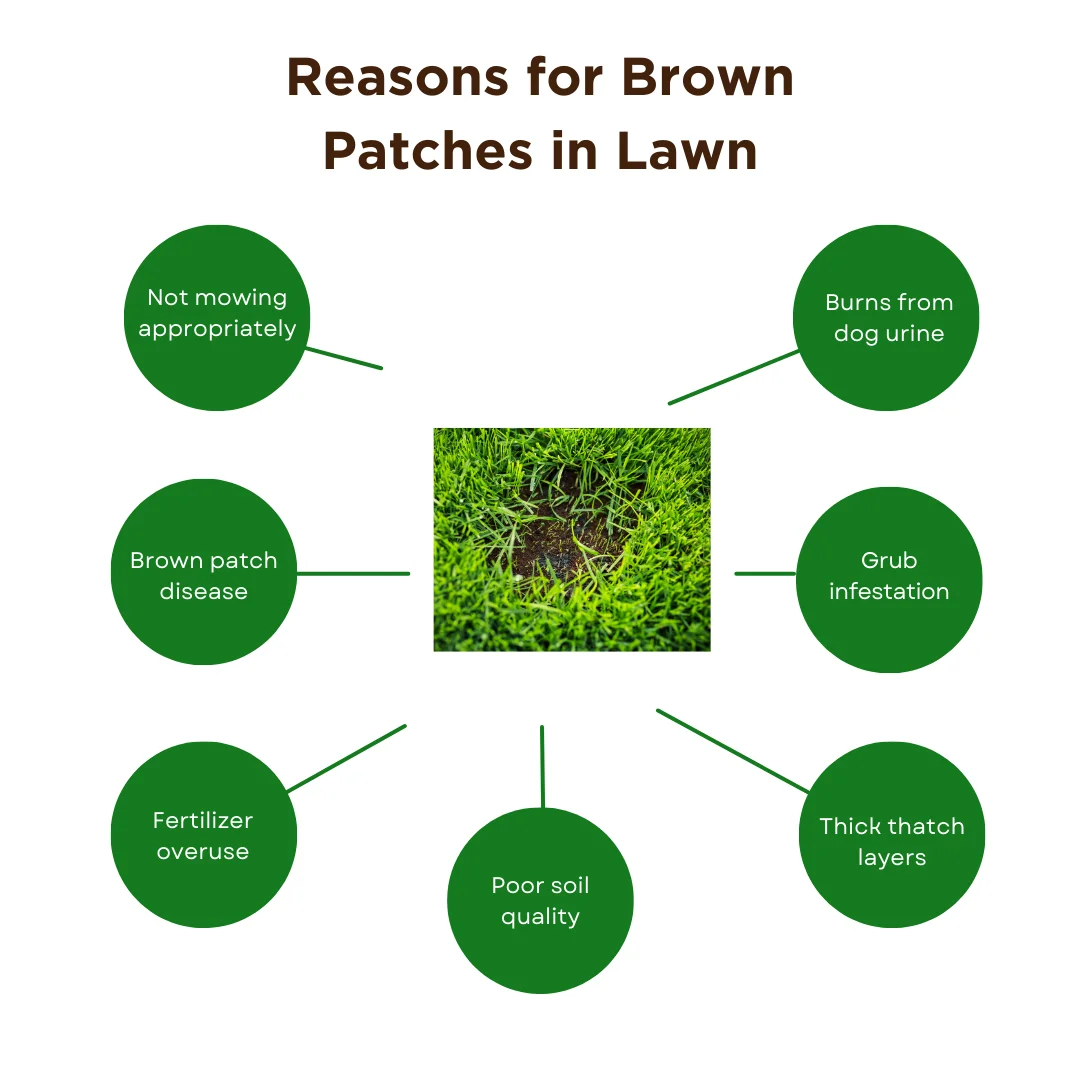Does your home look lacklustre due to the brown patches in the lawn?
There are several culprits to be blamed for brown patches in the lawn. So, to combat them, you need the best mode of action.
So, if you identify a change in colour in your, don’t just follow the first tip you see on the internet on how to fix brown patches in the lawn.
Instead, diagnose the problem and then direct a treatment.
Here, you will find whatever you need to identify and fix the brown patches.
So, let’s dig in!
Recognizing the Brown Patches in the Lawn

Brown patches appear in the lawn as round brown spots.
These can have a diameter ranging from a few inches to many feet. Strands of a web-like fungal growth known as mycelium may be visible on the grass blades in the early morning dew. In addition to discolouring, afflicted grass may eventually perish, turning your vibrant lawn into a real mess.
Using fungicides won’t always help, so the following are the problems causing brown patches in the lawn with their solutions.
How to Fix Brown Patches in the Lawn: 7 Reasons + Solutions

Below, you will discover what causes brown patches in the lawn and their respective treatments:
1. Not Mowing Appropriately
Because your grass grows so quickly in the summer, you may move ahead with regular lawn mowing. However, excessive grass growth prevents the sun from penetrating the surface and removing moisture and heat.
After carrying out your regular mowing, you may witness brown patches in the lawn.
Solution
Keep your mower’s setting 1/2 inch higher than usual during the summer.
Damaged and shredded grass will eventually die and may develop brown patches. Hence, sharpen your mower blades in the spring and fall.
To do all the steps of your lawn care right, you can read our blog on lawn care schedules.
2. Brown Patches In the Lawn Disease
Among all lawn diseases, brown patch is one of the deadliest. When the weather is just right, it creeps up on your lawn grass and nearly overnight destroys your thriving lawn.
Actually, it is a summer lawn disease. Brown patches in the lawn start to grow when the temperature reaches 65°F. Extremely high humidity levels promote the brown patch disease’s most aggressive growth.
A wide range of grass species are susceptible to brown patch disease. These grasses include bentgrass, tall fescue, ryegrass, etc.
Solution
Use the right fertilizer blend when fertilizing your lawn in the warmer months because high quantities of fast-release nitrogen accelerate growth. Mowing less frequently in hot weather can relieve tension and restrict the spread of grass disease.
3. Overuse of Fertilizer
Brown patches in the lawn may result from fertilizer containing too much nitrogen. When fertilizing your lawn, try to avoid doing this in hot, muggy conditions. Fungi react to nitrogen similarly to your grass; thus, an excess of nitrogen might strengthen brown patches more than your lawn.
Solution
Use a fertilizer with an appropriate NPK value.
The ratios of nitrogen, phosphorus, and potassium in the fertilizer are referred to as NPK. You may also inquire about the best fertilizer for your lawn and how to treat brown patches with its application from where you get it.
4. Poor Quality Soil
Without question and beyond, soil quality plays a major role in the lawn’s health.
Compacted or nutrient-deficient soil can hinder the root system and increase your lawn’s susceptibility to pests and diseases.
Furthermore, pH values might not be suitable for your lawn.
In our organic lawn care blog, you can find out how to test soil and fix it without using chemicals.
Solution
Testing your soil is the first step in improving your grass through aeration and soil modification. As a result, take action by taking care of the fundamental problems.
5. Thick Layers of Thatch Covering the Grass
It not only gives the fungi a place to dwell, but it also prevents water from seeping into the soil and reaching the roots.
Solution
Try aerating your grass in the late summer or early fall to help eliminate thatch. For the soil to absorb water, hundreds of tiny plugs must be removed during the aeration process. This step provides your lawn with the consistent watering, nutrients, and oxygen it requires.
6. Grubs Infestation in Lawn
Grubs are round, white beetle larvae that can cause damage down to a depth of several meters by feeding on the roots.
Subsequently, the brown patches in the lawn spread out over time. Because of the root damage and their eating pattern, the grass will have uniform, sponge-like brown areas that roll up when raked.
Solution
To get rid of grubs, try introducing beneficial nematodes or milky spores.
Although fall is the ideal season, you can take counteraction for grubs any time.
7. Burns from Dog Urine
Pets naturally harm grass, leaving scorched, barren brown patches or discoloured grass in their wake. The high concentration of nitrogen and associated salts that are naturally present in dog urine create brown patches in the lawn.
Especially. If you have a female dog, the concentrated pee that gathers in one place damages lawns.
Dog urine stains that cause minor lawn damage go away on their own as your lawn begins to develop again.
If the grass in your yard dies, revive the dead grass from the area.
Also, you can replace it with fresh overseeding.
Solution
There is one way of getting rid of the salts that mix with the lawn soil–watering. Only this can flush out the substance deemed as harmful and cause brown patches in the lawn.
Overwatering your lawn raises the possibility of brown patches when the soil is dry behind a wet covering. Water once every three to four days, nearly half an inch each time.
Early in the morning is the ideal time to water your grass since it avoids the intense light and helps prevent moisture from being trapped at the surface throughout the warmest portion of the day.
Maintaining Your Lawn
Brown patches in the lawn are sometimes the aftereffect of postponed lawn maintenance.
If no remedy on how to fix brown patches in the lawn works for you, replacing the area with sod is a quick solution.
FAQs
How to repair the area from brown patches in the lawn?
If required, reseed after removing the dead layer and treating the brown patch’s underlying cause.
Will the brown patch in the lawn go away?
Brown areas on the grass can eventually disappear depending on the factor causing it, but it may take some time. For instance, the patches from dog urine may disappear.
Are the patches’ brown grasses dead?
It is dependent upon the extent and length of the infection. Gently pluck on an infected blade to check for dead grass blades. The grass is dead if it pulls out without any resistance.
In Conclusion
This is how you can identify the reason behind the brown patches in the lawn and work on the best plan of action. Extreme high and low temperatures, poor soil quality, excessive nitrogen, thatch, and humidity are what can invite these unwelcomed guests to your thriving lawn.
Thankfully, Falcons Landscaping provides an ala carte of lawn care services to get your lawn thriving again!

